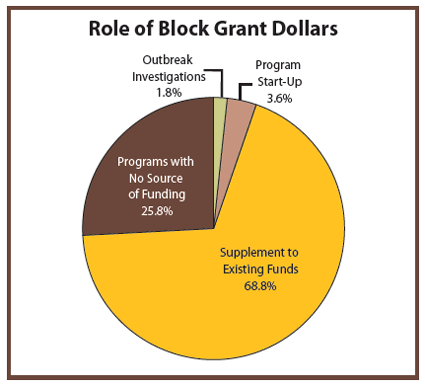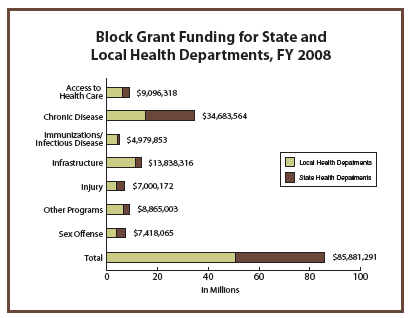 |
|
 |
 |
 |
PREVENTIVE HEALTH AND HEALTH SERVICES BLOCK GRANT
A Critical Public Health Resource
At A Glance
2009

The Role of Block Grant Funding
In 1981, Congress authorized the Preventive Health and Health Services (PHHS)
Block Grant. The PHHS Block Grant gives its 61 grantees—which include the 50
states and the District of Columbia, 2 American Indian tribes, and 8 U.S.
territories—the autonomy and flexibility to tailor prevention and health
promotion programs to their particular public health needs. States are
expected to align their programs with Healthy People 2010 national
health goals.
As a critical public health resource, the PHHS Block Grant supports the
following activities:
- Addresses basic health issues such as fluoridating water supplies,
improving food safety, and preventing falls among older adults.
- Responds rapidly to emerging health threats in states.
- Funds critical prevention efforts to address specific health issues,
such as skin cancer, child safety, and untreated dental decay, that lack
categorical state funding.
- Protects investments in and enhances the effectiveness of
categorically funded programs that address specific health problems.
- Leverages other resources of money for greater preventive health
impact.

[A text description of this map is also available.]
Flexible Funding for Public Health Efforts
The health needs of communities are diverse, complex, and constantly
changing. The PHHS Block Grant gives its grantees the flexibility to target
funds to prevent and control chronic diseases such as heart disease,
diabetes, and arthritis and helps them to respond quickly to outbreaks of
foodborne infections and waterborne diseases. The PHHS Block Grant provides
funding to grantees that can be tailored to address their particular public
health needs and challenges.

Funding Local Communities
The PHHS Block Grant is the major source of funding that CDC provides to
public health agencies to address health needs and problems such as
immunization, tuberculosis, cancer, and cardiovascular disease. The PHHS
Block Grant is a significant source of funding for health promotion and
disease and injury prevention in communities across the nation. However,
grantees do not have adequate funding to combat all the leading causes of
illness, disability, injury, and death in their states.
In Fiscal Year 2008 (FY 2008), approximately 43% of PHHS Block Grant
funds were distributed by the states to local entities to address county and
local public health needs.
For example, Maryland has given $67,000 of its PHHS Block Grant funding
to local health departments to use the American Diabetes Association Risk
Assessment Tool to refer at-risk adults to a health care provider and
risk-reduction activities in the community. Funds are also awarded to local
health departments to provide diabetes self-management education classes to
adults with diabetes who could not otherwise afford such services.
Leveraging Block Grant Funds
PHHS Block Grant funds also have provided start-up money for programs
that are now supported by other sources. As these programs have become
self-sustaining, PHHS Block Grant funds have been redirected to other public
health priorities.
For example, falls are the primary cause of injury leading to death for
older adults. Many seniors who experience fear of falling restrict their
activities. A Matter of Balance: Managing Concerns About Falls is an
evidence-based model developed by Boston University that uses community lay
leaders to teach older adults practical strategies to reduce their fear and
increase their activity levels. Using 2008 PHHS Block Grant funds, Kentucky
selected six counties to test strategies outlined in A Matter of Balance.
The program was so successful that the state allocated $90,000 from a
Kentucky osteoporosis program to increase the number of trainers and
facilitators statewide.

[A text description of this map is also available.]
Meeting Health Care Needs When No Other Funds Exist
Tooth decay can affect a person’s quality of life, causing pain,
difficulty in eating, and weight loss. Community water fluoridation helps
prevent tooth decay safely and effectively. Florida used its PHHS Block
Grant funds to initiate the Fluoridation Project, which provides technical
assistance to communities making fluoridation available through their local
water systems. In 2008, 77.6% of Florida’s residents had access to
fluoridated water. The program also provides funding to educate community
members and other decision makers about the benefits of fluoridation. Before
the program’s inception in 2007, only 25% of Florida’s residents received
fluoridated water.
In California, PHHS Block Grant dollars provided the primary funding for
Project Lean, a program that was instrumental in changing school nutrition
policies. As a result of the project, two landmark policies that address
food and beverage standards in California schools were passed. The first
policy limits the total fat, saturated fat, sugar, and calories allowed in
foods sold outside the Federal Food Programs to students at California
public elementary, middle, and high schools. The second policy restricts the
sale of soft drinks on California high school campuses. This policy builds
on a previous state policy that had addressed soft drink sales only in
elementary and middle schools.
In Nebraska, the PHHS Block Grant-funded Diabetes Program focuses on
preventing diabetes-related death and disability and eliminating the risk
factors that lead to the development of type 2 diabetes in Nebraska’s
minority population. PHHS Block Grant funds expand the services provided by
the Nebraska Department of Health and Human Services’ Nebraska Diabetes
Prevention
and Control Program (NDPCP). The funds allow the NDPCP to contract with
providers of care for minority populations and people with low-incomes and
with a school that has developed a nutrition and physical activity program
to help prevent diabetes in Native American children.
Block Grant Management Information System
The PHHS Block Grant Application and Reporting System (GARS) has been
used for over 10 years to track grantees’ progress toward achieving their
objectives. The system is one of CDC’s first electronic grants management
systems.
However, current CDC, grantee, and national needs require a more flexible
and accessible system to meet stakeholders’ demands. As a result, CDC
developed the Web-based Block Grant Management Information System (BGMIS) to
replace GARS. In 2008, CDC successfully transitioned the PHHS Block Grant
from GARS to the BGMIS.
The new system provides improved accessibility and usability of grantee
information and integrates critical PHHS Block Grant information. The BGMIS
captures and reports on federal block grant work plans and other information
submitted by grantees each fiscal year. The system contains current data
on the grantees’ reporting requirements and work plans.
In 2009, CDC will expand the system to collect information on performance
measures, annual progress reports linked to performance measures, success
stories demonstrating health outcomes, and compliance review information.
The BGMIS also will be enhanced to streamline data collection and support
national evaluation, monitoring, communication, and dissemination efforts
for the PHHS Block Grant.
Future Directions
In 2008, CDC, PHHS Block Grant State Representatives, the National
Association of Chronic Disease Directors (NACDD), the Association of State
and Territorial Health Officials (ASTHO), the Directors of Health Promotion
and Education (DHPE), and other partners convened on two occasions to
discuss ways to increase support for sustaining and expanding the PHHS Block
Grant. At the meeting sponsored by ASTHO, senior state public health agency
leadership and ASTHO affiliate representatives recommended making the PHHS
Block Grant more accountable and innovative by better defining its goals and
parameters and building a stronger constituency.
NACDD convened a 2-day meeting with representation from DHPE, NACDD, CDC,
PHHS Block Grant states, Emergency Medical Services, and past block grant
leadership to address ASTHO’s recommendations and identify next steps. The
participants identified national overarching goals for the PHHS Block Grant
and recommended that the Block Grant (1) develop and implement an evaluation
plan, (2) develop core performance measures based on the overarching goals,
(3) increase monitoring and technical assistance to grantees, and (4)
continue to improve grantee capacity to identify and use evidence-based
guidelines and best practices to design and implement effective public
health programs in communities across the country.
During the next 2 years, the PHHS Block Grant has placed a priority on
engaging its partners to develop and implement an evaluation plan, develop
and implement core performance measures, and increase monitoring and
technical assistance to grantees. The PHHS Block Grant will continue to
improve capacity and demonstrate its important contribution to public
health.
Back to top
Success Stories
Texas
A large—and growing—number of residents of Williamson County, Texas, are
at risk of developing life-threatening diseases such as diabetes and heart
disease. Community nutrition surveys
confirm that residents of the central Texas county are eating foods that are
low in nutrition and high in calories. In addition to a higher risk for
premature death, an unhealthy diet is also associated with the burden of
high cost on the medical care system.
To promote a healthy diet, Preventive Health and Health Services (PHHS)
Block Grant funds were used to develop and implement the Community Garden
and Nutrition Program, which encourages participants to grow and eat their
own fresh seasonal fruits and vegetables. Williamson County and Cities
Health District (WCCHD) formed partnerships with local volunteer
organizations, cities, and school districts to establish the gardening
program.
Using PHHS Block Grant funds, WCCHD hired a horticulturalist to lead the
Community Garden and Nutrition Program. Since 2005, the horticulturalist has
designed the first Expert Gardener Certification course, created a gardening
education curriculum, and developed and taught “From the Garden to the
Table/Del Jardín a la Mesa,” cooking and nutrition classes for both English-
and Spanish-speaking participants. Participants who are gardening also are
benefiting from low-impact physical activity.
The Community Garden and Nutrition Program has been successful in raising
awareness among county residents about community gardening, improving
nutrition, and increasing physical activity.
In particular, the program has
- Certified 165 Expert Gardener volunteers.
- Provided gardening, cooking, and nutrition classes to more than 400
participants.
- Donated more than 5,000 pounds of fresh, organic produce to local
food pantries, Meals on Wheels, nursing homes, retirement facilities,
and free lunch programs at a local senior center.
- Hosted field trips for about 1,700 preschool-aged children and 650
school-aged children.
Virginia
Chronic diseases are the leading causes of death for Virginians. It is
estimated that 2.2 million Virginians live with one or more of the following
chronic diseases: heart disease, stroke, cancer, asthma, diabetes, and
arthritis. The annual cost of chronic disease in Virginia totals $24.6
billion; nationally, chronic disease annual costs represent approximately
75% of the nation’s $1.4 trillion annual health care costs.
Virginia is proactive about chronic disease prevention and control.
Programs such as the Chronic Disease Self-Management Program (CDSMP) provide
the information and resources needed to help reduce risks and promote
healthier lifestyles. Since 2005, PHHS Block Grant funds have been used to
bring this program to areas of the state that have a higher prevalence of
heart disease, stroke, high blood pressure, and diabetes. In health
districts across the state, the CDSMP coordinator recruits adults living
with chronic diseases as well as their caregivers. Program participants
complete a 6-week course that teaches self-management strategies such as
medication management, pain management, and relaxation techniques.
Because the program offers strategies that promote self-management
techniques, participants are improving their skills in managing their
chronic diseases, using more self-management strategies, and adopting
healthy lifestyle behaviors (e.g., increased walking, better diet, proper
use of medications). Participants are also reporting a decrease in hospital
visits, which could potentially save Virginia thousands of dollars in health
care costs.
In 2006, CDSMP completed three leader trainings that resulted in 25 new
leaders who are now teaching CDSMP in two health districts. Some program
participants have become leaders. With continued support, CDSMP will help
Virginians spend less time in the hospital and more time practicing
self-management strategies to improve their health.
Kansas
Lawrence and Douglas Counties in Kansas are working to reduce the number
of overweight and inactive children and adolescents. In 2001, Wakarusa
Valley Elementary school in Lawrence became the first Douglas County school
to launch Get Moving!, a program that encourages early prevention of
obesity. With PHHS Block Grant funds, the Get Moving! program focuses on
participation in physical activity outside the physical education program in
schools, encourages families to exercise together (especially during the
winter months), and aims to increase the percentage of children and families
who participate in regular physical activity.
 Program elements include the following:
Program elements include the following:
- A supply of Get Moving! cards. Participants use the cards to detail
up to 12.5 hours of physical activity recorded in 30-minute increments.
- Any type of physical activity done outside of school time may be
recorded on the card.
- Participants receive extra points for involving a “buddy” (family or
friend) in the activity.
- Participants record the days they consumed at least five fruits and
vegetables.
- Prizes are awarded for the first three cards returned during the
year. A pool pass to the indoor or outdoor Lawrence Aquatic Center is
awarded when the fourth card is turned in.
- The class with the highest participation percentage wins a pool
party.
Over the past 5 years, the Get Moving! program has grown to include
all 26 schools and educational service centers in Lawrence and 20 elementary
schools in surrounding communities. During the 2004–2005 school year,
- The number of students completing at least four cards jumped from
256 to 753.
- Participants in the 1st–6th grades increased their physical
activity, recorded in 30-minute increments, more than 6,000 hours.
- The number of cards turned in increased by 2,312.
A program that started in one Douglas county school has grown to become
an effective and fun way for schools throughout the county to combat the
growing epidemic of childhood obesity and the chronic health issues caused
by this condition.
Back to top
Related Materials
Back to top
|
For more information please contact
Centers for Disease Control and Prevention
National Center for Chronic Disease Prevention and Health Promotion
4770 Buford Highway NE, Mail Stop K–30, Atlanta, GA 30341-3717
Telephone: 770-488-5080 • E-mail: cdcinfo@cdc.gov
Web: http://www.cdc.gov/nccdphp/blockgrant
|
|
 One or more documents on this Web page is available in Portable Document Format
(PDF). You will need Acrobat
Reader (a free application) to view and print these documents.
One or more documents on this Web page is available in Portable Document Format
(PDF). You will need Acrobat
Reader (a free application) to view and print these documents.
Page last reviewed:
January 15, 2009
Page last modified: January 15, 2009
Content source: National Center for
Chronic Disease Prevention and Health Promotion
|
 |
![]() One or more documents on this Web page is available in Portable Document Format
(PDF). You will need Acrobat
Reader (a free application) to view and print these documents.
One or more documents on this Web page is available in Portable Document Format
(PDF). You will need Acrobat
Reader (a free application) to view and print these documents.